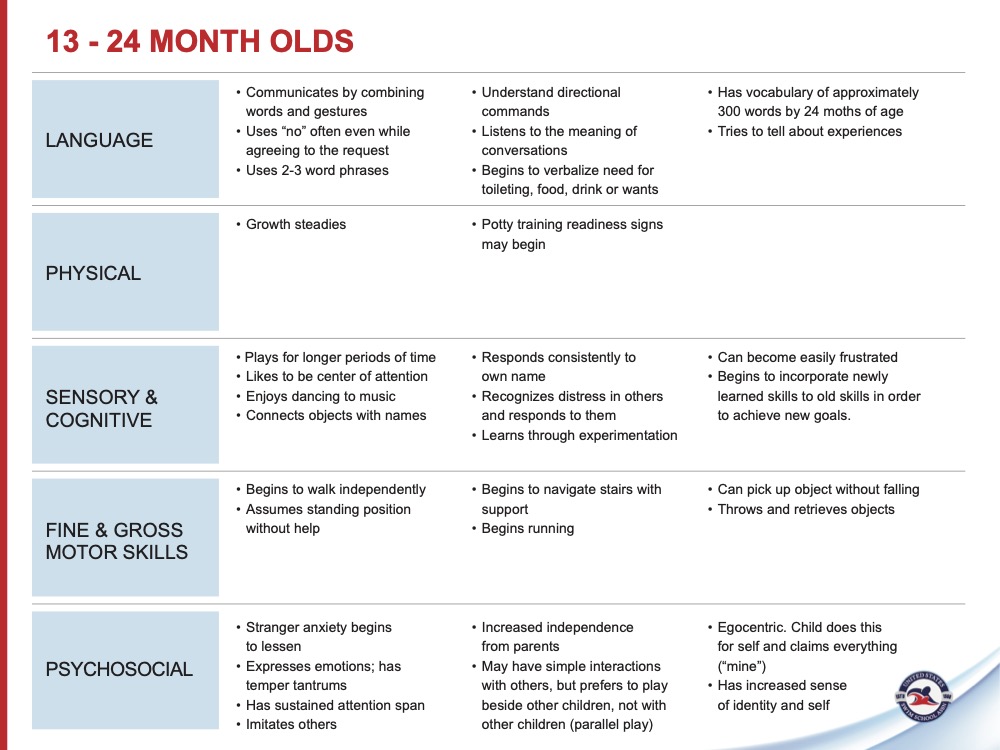WELCOME everyone! Enter the Pool and Gather in a Circle. Greet each adult/child pair and take time to allow babies and caregivers to adjust to the water. Introduce yourself, talk about what an amazing journey this will be with the caregiver and the baby. Demonstrate the Little Harbor Hold. Caregivers lengthen their arms to support their student under the armpits. Allow babies to explore the feelings of buoyancy and balance with support and you encourage caregivers to support as low in the water as possible so babies can learn to stabilize themselves (parents may need to bend their knees slightly to achieve this).
Welcome Song in Little Harbor. Gather parents into a circle and Talk To The Group. Ask the group if they have any questions about having their babies in the water and what they are most excited to gain from the class! Sway back and forth in little harbor while parents and infants get adjusted and relaxed. Next, sing the song and encourage the Parents to sing and splash along.
Conditioning and Swimming on the Steps. Instruct parents to take a seat on the steps and/or the big mat, or place their back against the wall for balance and create a seat for their child by lifting a leg and bending a knee. Pass out a cup or watering can and encourage parents to begin by pouring water gently from the back of the child’s head to the front so it is less intimidating. This technique is used to teach the students to hold their breath in response to the water being poured over their head, eyes, nose and mouth. Conditioning is the foundation of good breath control!
FOR MORE ADVANCED STUDENTS; Rotate around to each parent and child pair for an underwater swim from teacher to step while the others are conditioning. During the initial introduction of learning breath control, submersion of young children must be brief (approximately three seconds) and few in number (no more than six per lesson). Once the child can consistently initiate the submersion AND can demonstrate competent breath control, submersion can become longer and more frequent.
Back Float with Small Mirrors. Encourage parents to support their children on their backs and tip toe around the pool in a circle. Each pair can hold up a small mirror for gazing upward. Encourage parents to assist with the back of the child’s head and ears underwater!
Swimming Under and Rolling Over. Place a pool noodle on the surface of the water and take turns passing each child from instructor to parents. Aim to submerge completely under the noodle and roll to the back for the finish. Encourage parents to pause with the child on the back to allow the water to fall away from the face and relax the child in th back position.
During the initial introduction of learning breath control, submersion of young children must be brief (approximately three seconds) and few in number (no more than six per lesson). Once the child can consistently initiate the submersion AND can demonstrate competent breath control, submersion can become longer and more frequent.
Blast Offs on Front and Back. Instruct parents to support children on front by holding under the chest with their feet against the wall. Countdown 3 – 2 – 1 BLAST OFF, babies push off the wall and parents tip toe across the space moving from the ropes and back. Repeat this activity times on the front then assist parents with supporting on the back for a few more blast offs. Use the supporting techniques that were practiced earlier. TIP; Placing a target on the wall for each parent/baby (such as a colored cone and mirror) tol help with spacing during the blast offs and direction on the way back.
FOR MORE ADVANCED STUDENTS; Encourage parents to pause on the way back from the rope and cue students to submerge on their way to the wall. It helps to place a mirror on their target to reach for.
Fishes in the Ocean. Parents support babies in a seated position on the edge of the pool. Explain to parents that if that now is the chance to submerge gently under their water after the three count. Note; When babies are first learning to submerge it is appropriate to take them under the water for up to 3 seconds and the maximum number of submersions per class is 6.
Wheels on the Bus. Gather students and parents into a circle and float some toys in the center of the circle. Wrap up the class with any announcements, then encourage parents to follow along with the movements of the yellow bus as you move around the pool one last time.
- Watering Can
- Noodles
- Cones
- Small Floating Mirrors
- Squirt Cars
- Bus








